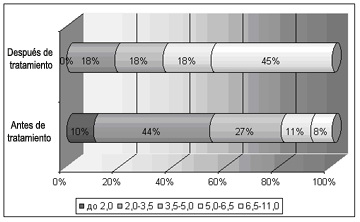DENS-THERAPY IN COMPLEX TREATMENT OF MYOPIA OF CHILDREN AND TEENAGERS
A.A. Ryabtseva, M.M. Savina, V.S. Savin, P.I. Shaldin
MONIKI named after M.F. Vladimirsky, Moscow
Podolsk City Clinical Hospital, Podolsk, Russia
Dynamic electroneurostimulation is a modern method of reflexotherapy, which can be applied when treating eye diseases both as monotherapy and in the complex with other methods of physical treatment.
The article presents the results of complex treatment of myopia and accommodation spasm which included DENS-therapy, color and magnetostimulation and accommodation training. Reliable efficiency of the proposed method of treatment was observed, which is confirmed by increase of visual acuity by 0.14 on average, reduction of the accommodation tone by 0.3 diopters, increase of the reserves of relative accommodation (RRA) by 2.98 diopters, improvement of other functional indexes. This allows us recommending the proposed method of treatment for application in the ophthalmologic practice.
Key words: dynamic electroneurostimulation, color and magnetostimulation, accommodation training.
A need for prophylaxis of myopia development is caused by its vital role in the amount of eye diseases (25-35 %) and its trend for dynamic growth [1, 3]. Myopia progressing is associated with an increasing world computerization. In this connection, elaboration of modern efficient methods of myopia treatment using the principle of “biological feedback” is a task of great importance. Mechanisms of influence of the therapeutic factors, which comprise complex therapy, make eye hemo- and hydrodynamics normal, improve microcirculation by usage of their complementary influence and increase of visual functions and, thus, promote prevention of myopia development.
Purpose of the present research was to study therapeutic efficiency of the complex method of treating accommodation spasm and myopia including dynamic electroneurostimulation (DENS), color and magnetocorrection (CMC) and accommodation training. For this, we carried out treatment of noncomplicated myopia of the slight and medium form and accommodation spasm of 33 patients (66 eyes) in the age from 8 to 19 years.
Table 1
Distribution of Supervision Depending on Refraction, Gender and Age of Patients
Number of Patients |
% |
||
Gender |
male |
13 |
39% |
female |
20 |
61% |
|
Age |
8 - 13 years |
19 |
58% |
13 – 18 years |
14 |
42% |
|
Number of Eyes |
% |
||
Refraction |
Em – Hm |
12 |
18% |
Slight Myopia |
30 |
45% |
|
Medium Myopia |
24 |
36% |
|
Total |
66 |
100% |
|
Methods of examination and treatment. Examination was carried out by standard methods and included visiometry with optimal correction and without it, determination of dynamic and static refraction, accommodation tone, reserve of the positive part of relative accommodation (RRA), reserve of distance accommodation (RDA), critical flicker fusion frequency (KFFF) to red and green colors.
Dynamic electroneurostimulation of the paraorbital zone was carried out with “DENAS+” apparatus with external paraorbital electrode (EPE) “DENS-glasses”. DENS was applied in the MED program and “therapy” mode at frequency 77 Hz with 5 minute exposure. The principle of this method operation lies in therapeutic influence on reflexogenic zones and biologically active points of the paraorbital area with short bipolar current impulses of different frequency, which form changes depending on the impedance of tissues in the subelectrode zone. The principle of “biological feedback” is applied.
“Rucheek” apparatus (“Medoptika TAK-2”) was applied for accommodation training, effect of which is achieved by discrete serial presentation of signs at fixed distances from the eye. Under occlusion of the eye not in function, monocular principle of operation was followed. Accommodations trainings were carried out with optimal correction for long distance vision. Training course consisted of 10 procedures, 5 minutes for each eye.
1-2 minutes after the accommodation training, treatment by method of color and magnetostimulation with apparatus “Medoptika CMS-11” was applied. Function of the apparatus is based on stimulation of the optic tract with synchronized light and magnetic pulses. Pulses frequency was synchronized with the patient’s bloodstream pulse. Magnetic field exposure was carried out on the area of orbital cavity, temporal region at the external edge of the orbital cavity, on auricular-temporal region in the optic chiasm projection, on the occipital region in the projection of cortical part of the visual analyzer. Treatment course consisted of 10 procedures carried out every third day.
Results of treatment. During the research good tolerance of the proposed treatment course was registered in all patients. It was registered, that 96 % of patients had asthenopia effects disappeared or considerably diminished as well as visual efficiency significantly increased. During the efficiency analysis of treatment in compliance with the proposed method, a reliable improvement of functional indexes of eyes is revealed in general (table 2, table 3).
Table 2
Dynamics of Particular Functional Indexes of Eyes under the Influence of Complex Treatment
Functional Indexes |
Before treatment М±m |
After treatment М±m |
P |
Visual acuity |
0.26±0.04 |
0.4±0.03 |
<0.05 |
Dynamic refraction (dptr) |
2.92±0.7 |
2.62±0.08 |
<0.05 |
RRA, (dptr) |
3.95±0.08 |
6.93±0.07 |
<0.01 |
RAA, (dptr) |
3.4±0.08 |
6.4±0.09 |
<0.01 |
KFFF red, (Hz) |
47.9±0.9 |
50.5±0.8 |
<0.05 |
KFFF green (Hz ) |
44.1±0.6 |
44.6±0.7 |
>0.05 |
Before the treatment course visual acuity without correction was 0.26±0.04; after the treatment course it was increased to 0.41.±.0.03, on average by 0.14 (р<0.05). And increase of visual acuity by 0.3 and more was discovered in 38 % of cases.
Weakening of dynamic refraction was observed on average by 0.3D from 2.92±0.08 dptr to 2.62±0.08 dptr (р<0.05). Accommodation tone determined as difference between a dynamic and static refraction was reduced from 0.33 dptr to 0.02 dptr (р< 0.05).
A statistically reliable increase of the reserve of absolute accommodation by 2.96 dptr from 3.4±0.08 dptr to 6.4±0.09 dptr (p<0.01) was observed. The reserve of relative accommodation increased by 2.98 dptr (р < 0.01) and on average was 6.93±0.07 dptr. Restoration of the accommodation reserve to the age standards was observed in all patients, whereas before treatment indexes of RRA norm were observed only in 50 % of cases. And the group with high RRA indexes (>6.5 dptr) amounted to 45 % as compared with 8 % before treatment (Fig. 1).
Fig. 1. Distribution of RRA before and after the Treatment Course
During study of KFFF indexes, their improvement from 47.5±0.8 Hz to 50.26±0.78 Hz (р<0.05) to the red color and from 43.8±0.75 Hz to 44.3±0.52 (р>0.05) to the green color was observed.
Table 3
Functional Indexes of Eyes Depending on the Initial State of the Clinical Refraction
Functional Indexes |
Static Refraction |
||
Hm - Em |
Slight Myopia |
Medium Myopia |
|
n=12 |
n=30 |
n=24 |
|
Visual Acuity |
0.15±0.02 |
0.2±0.02 |
0.05±0.01 |
Dynamic Refraction, (dptr) |
(-)0.06±0.06 |
(-)0.43±0.08 |
(-)0.25±0.06 |
RRA, (dptr) |
2.06±0.09 |
4.1±0.07 |
2.03±0.07 |
RAA, (dptr) |
2.0±0.05 |
3.14±0.08 |
3.34±0.09 |
KFFF red, (Hz) |
3.0±0.5 |
1.33±0.2 |
3.75±0.4 |
KFFF green, (Hz) |
0.9±0.6 |
0.66±0.8 |
2.14±0.8 |
Analysis of indexes dynamics depending on the eyes refraction value (table 3) shows that during treatment in compliance with the proposed methods, the most pronounced results were achieved when treating slight myopic refraction. It can be associated with direct stimulating influence on the weakened ciliary muscle and not only by reflex influence to which accommodation spasm is “more responsive”.
Thus, the proposed treatment course, which includes dynamic electroneurostimulation, color and magnetocorrection and accommodation training improved functional adaptive mechanisms of the visual analyzer and is an efficient method in the complex treatment of the accommodation spasm and slight and medium myopia.
Sources
- E.S. Avetisov. Pathogenesis of Myopia, Prophylaxis of its Progress and Complications. – M., 1999. – pp. 9-14.
- S.Yu. Bogacheva, Ya.V. Malakhova. Pathogenetic Grounding and Practical Application of DENS for Treating Children’s Myopia // Dynamic Electroneurostimulation. New Step in the Experience. – Collection of Materials of the International Medical Symposium devoted to the 7th anniversary of the “DENAS MS” Corporation. – Ekaterinburg, 2005. – pp. 124-131.
- E.S. Libman, E.V. Shakhova, V.M. Vervelskaya. Clinico-Social Aspects of Incapacitating Myopia / Myopia, Disorders of Refraction, Accommodation and Oculomotor Apparatus: theses of reports of the international symposium. – M., 2001. – pp. 55-56.
- Nguen Thi Min. A Combined Method of Treating Slight and Medium Myopia of Children: abstract of the thesis for candidate of medicine. – M., 2002 г.
- V.M. Sheludchenko, Yu.Z. Rozenblum, M.G. Kolotov. Change of Objective Indexes of Accommodation under Myopia and Assessment of the Results of Accommodation Trainings // Ophthalmology Herald. – 2000, No. 2. – pp. 25-27.
- S.L. Odintsov. Color and Magnetostimulator “Medoptika CMS-11” in Treating Pathologies of the Optic Nerve and Retina // VIII Congress of Russian Ophthalmologists. Moscow, 1-4 June, 2005. Theses of Reports. – p. 420.
- V.V. Okovitov. Methods of Physiotherapy in Ophthalmology. – M.: Meditsina, 1999. – 58 p.
- A.Yu. Rossoshansky, V.V. Chernyshev, D.V. Ivanova. First Encounter of Application of DENSICVET Apparatus for Treating the Accommodation Spasm and Myopia / Dynamic Electroneurostimulating Therapy. Evolution Continues. – Collection of Materials of the International Medical Symposium devoted to the 6th anniversary of the “DENAS MS” Corporation, - Ekaterinburg, 2004. – pp. 146-150.
- Z.M. Safina. Local and System Mechanisms of Vision Improvement after Electrostimulation of the Optic Tract // Electrostimulation – 2002: theses of reports of the scientific and practical conference. – M., 2002. – pp. 295-298.
- Sh.D. Tairova. Dynamic Electroneurostimulation in Ophthalmology // Dynamic Electroneurostimulation. New Step in the Experience. – Collection of Materials of the International Medical Symposium devoted to the 7th anniversary of the “DENAS MS” Corporation. – Ekaterinburg, 2005. – pp. 211-214.


 Fisioterapia
Fisioterapia

